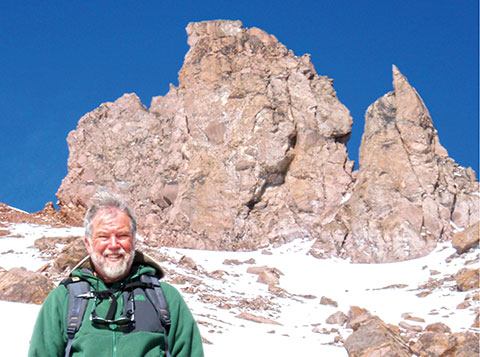A life, mine, is vectoring again toward something that may carry regrets. Isn’t that true of almost everything?
On July 12, 2014, off on the same vector, that life achieved by foot travel an altitude about three-quarters of a mile higher than the summit of Mt. Everest, relativity being what it is.

The author at Whymper’s Needles on Chimborazo. (Photo credit Romulo Cardenas)
If one measures from the center of the Earth, because our plastic globe spinning at about a thousand miles an hour bulges a little at the equator, Chimborazo in Ecuador is about 7,000 feet higher than Everest, which is somewhat more northerly, away from the bulge.
Judged the usual way, mean local sea level, Everest is about 8,500 feet higher. Does this mean that side by side in Nepal Chimborazo would tower above Everest to about 36,000 feet above sea level compared to Everest’s 29,035? The Internet, which never lies, says Chimborazo’s summit is 20,946,194 feet from the center of the Earth, and Everest’s is 20,939,304.
Ordinarily, none of that would matter much to an old guy. Yet, some kinds of relativity come more into focus with age. They provide motivation for eliminating some regrets of the worst kind, those of things undone.
Climbing to the highest point on Earth remains undone. Climbing the one in Nepal is probably now beyond my capability.
Not just the plastic Earth and liquid oceans, but the air as well bulges at the equator. Even so, high on Chimborazo, and high on any high mountain, can be very cold. Mountain climbing cannot be done in places that reliably stay warm.
The sun, to us both friend and enemy, has greater strength in both roles near the equator. Most summit attempts on Earth’s highest mountains start around midnight. That’s when things are locked in place by several hours of freezing with no sun in the visible sky. The snow, rocks, and ice thus are less able to injure or kill those climbing below or on them.
~ Read the rest of this story in today’s Journal ~








Facebook Comments